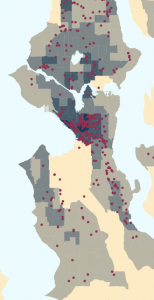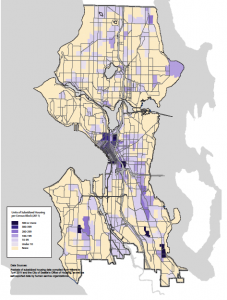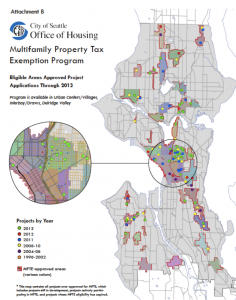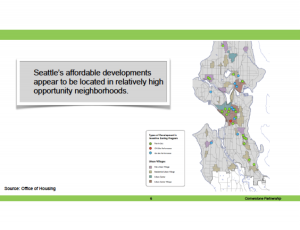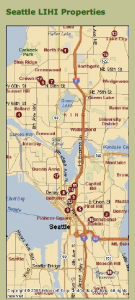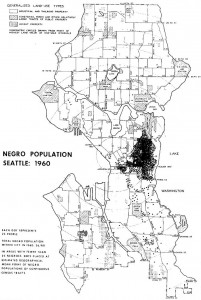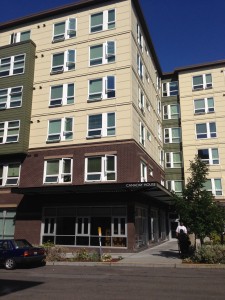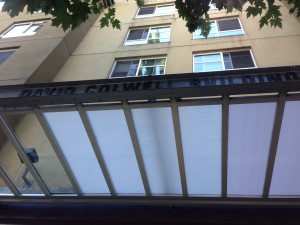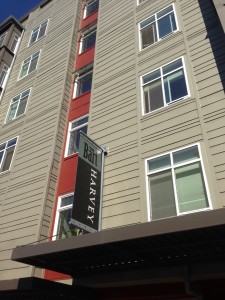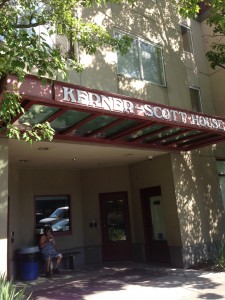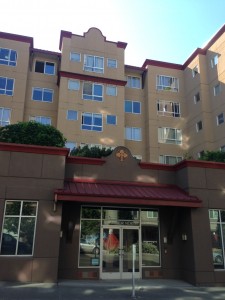Daily Troll: Dear Joe, Give Me A Call!
There are days when there are so many things going on that I simply don’t have the hours in the day to respond to everything popping up in the media. Recently embittered neighbors (you can read Leroy Laney’s poetry here) “won” a lawsuit against a project on Harvard (and it was the City that “lost” since the neighbors sued them for their interpretation of their own code). All they’ve done is delay the project (the image above this post is from the comments section at Capitol Hill Seattle Blog).
I will probably do a more comprehensive post on that decision later, but for now here’s my e-mail to Joe Copland at Crosscut. Joe is a great journalist and I worked with him for a long time at Crosscut. This isn’t a slam on Joe, but just the fact that we are still fighting an uphill battle to shift the narrative away from the default one which is all about developers breaking the law for fun and profit. So my note to Joe will have to serve as our response for now. I also comment on another item in the Daily Troll about family housing.
Hi Joe,
First, when I get a minute I will likely post a clarification of what’s going on with the micro decision.
This is an elected judge siding with the neighbors. Yeah, yeah, I know. That’s what you’d expect I’d say. But a closer look will show that the City’s code allows this interpretation. It’s nothing sneaky. Our system allows people to challenge the underlying assumptions of a law. The judge is essentially saying, “yes it’s code compliant, but the underlying code is bad.”
This is really, really important. The rhetoric is that somehow projects are “violating the law.” No, they are following a law you don’t like. There’s a big difference.
With regard to family housing, that’s the point we’ve been making again and again the adverse decisions made by Council lately that put a squeeze on single-family housing. Making it harder to build single-family housing isn’t going to make family housing easier. In fact, as I pointed out in a recent post, the rules we’ve erected around the single-family zone wall out families looking for affordable housing.
Trying to change the narrative about the greedy developers trying to skirt the law for profit and to squash the little guy isn’t your job; its mine. But when this stuff comes up give me a call for background and I’m glad to at least give the other side.
Roger–
Microhousing: 6 Charts You Should See
Sean Keeley at Curbed Seattle has a post called 6 Charts that Show Seattle Needs More Micro-Apartments. The post takes some existing charts and puts them together to illustrate the point that more and more people are living alone. That makes it impossible to share rent costs. That means that building new housing that accommodates that demand is going to be imperative to keep prices down. Based on one of his charts:
There’s a good 200K Seattleites who might be willing to trade space for lower cost of living. And clearly, given the never-ending list of new microhousing projects around town, we haven’t met demand yet.
But, as we’ve pointed out, angry neighbors get their way supply will go down and we’ll get fewer units. That just means higher prices.
Where Has All the (Affordable) Housing Gone? Everywhere.
Last week I responded to Chris Persons at the Capitol Hill Housing Improvement Program (CHHIP) who claimed that without inclusionary zoning, Seattle would end up a segregated city. I’ve offered Persons a chance to post a response here, without any editing, to keep the dialogue going (he hasn’t responded). And I have said to him and others, that everyone building housing in the city, for-profit and non-profit, have more in common than we might think.
Anyone building housing in Seattle faces the same regulatory challenges with permitting and other costs associated with building. In the follow up discussions from my post, I’ve been finding out that taking a pass on mandatory inclusionary zoning won’t lead to segregation by race and income, but, arguably, segregation of affordable housing doesn’t exist today. On the contrary, subsidized affordable housing exists in all quarters of the city.
Here are two maps created by the Office of Housing that illustrate the wide distribution of housing and where it is most concentrated.
(Click there to see the full map: Seattle Subsidized Housing by Housing Density)
(Click here to see the full map: Seattle_Block Group Map_Subsidized Housing Density)
Clearly , the city has a lot of buildings and units of subsidized affordable housing. There are areas (especially larger SHA operated housing areas like Holly Park and Rainier Vista) where there is still a much greater concentration than in other areas. But those areas are matched by many, many areas where there are lots of units and projects.
What about the Multifamily Tax Exemption (MFTE), a program aimed at people who earn 60 to 80 percent of Area Median Income (AMI) that has created thousands of units compared to the hundreds created by the underutilized Incentive Zoning program?
(Click here to read the full report: MFTE Annual Report)
Because the MFTE program is actually limited to urban villages and other areas of growth, when the program grows it creates more affordable housing in those places where Persons and supporters of inclusionary zoning say housing at 60 to 80 percent needed the most. The facts show that the MFTE program is creating housing priced at for 60 to 80 percent AMI all over the city at a rate much faster than Incentive Zoning, which produced, over a decade, only about 600 units. In 2013 alone, the program created over 3,000 units for people earning 60 to 80 of AMI.
What did the consultants hired by the City Council tell them about the distribution of housing in the city?
(Click here to see the full Power Point Presentation)
Cornerstone says that “Seattle’s affordable developments appear to be located in relatively high opportunity neighborhoods.” That includes neighborhoods like South Lake Union which has hundreds of MFTE units (see photos below) as well as larger buildings that are aimed at families, like the Denny Park Apartments. Here’s a description of that property from the Low Income Housing Institute’s (LIHI) website:
Denny Park Apartments (South Lake Union, Seattle)
50 units for families and individuals
26 studios, 11 one-bedrooms, 8 two-bedrooms,
5 three-bedrooms, 10 units are transitional
Here’s a map of LIHI’s properties which are all over the city, including in Queen Anne and Ballard:
Yet the hyperbole from the Housing Development Consortium continues unabated. Here’s a quote from a post by Emily Alvarado from in early in 2013:
For years, zoning has been a tool of exclusion designed to systematically segregate neighborhoods. But, Incentive Zoning can be a tool for equitable growth, helping build economically and racially integrated communities that enable modest wage workers benefit from urban reinvestment and connect to better schools and opportunity networks.
Then she posts this old map:
The implication is obvious. Do what we say and impose inclusionary zoning or you will be participating in a racist and segregationist policy. Of course Persons and Alvarado will gasp and clutch their pearls at such a suggestion, but the maps show clearly that they are wrong on the facts of what’s happening in the city and about incentive zoning’s value as a policy to reverse segregation, even if it existed. The only affordable housing program creating lots of units with limits on its location is the highly successful MFTE program.
What’s truly unjust is the gross misallocation of resources, rhetoric, and time that this city, the Council, and housing advocates of all kinds have wasted on a policy that so clearly does little to solve any problems, especially the one we don’t have, which is the supposed undersupply of workforce housing. The scarcity is at lower levels of income, and while waiting lists for that housing grow as does the suffering of poor people, Persons, the Housing Development Consortium, and some Councilmembers plow ahead, using the politics of race and class welfare to tax new housing to funnel subsidies to people that earn $50,000 to $60,000 claiming that it will integrate and better distribute subsidized housing. Where has all the affordable housing gone? It’s everywhere.
While I was writing this on Capitol Hill I ran down and across the freeway to get a quick picture of the Denny Park Apartments. But I realized I was disoriented. The Denny Park Apartments are further away than I thought. So I snapped pictures of these 6 affordable buildings in about 5 minutes. I haven’t calculated how many units of housing I was able to identify on foot, without a map, and just looking at the outsides of the buildings. I came back and confirmed the names, ownership, and addresses of the buildings. The next time someone says the South Lake Union has no poor people, or that people are being displaced to make way for luxury apartments consider these actual people living there today. Then tell me we’re segregating our city.
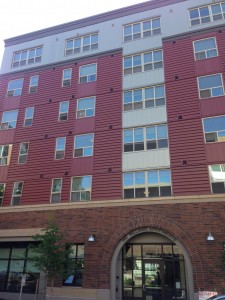
Pat Williams Apartments
Plymouth Housing Group
Pat Williams Apartments
219 Pontius Ave N., Seattle, WA 98109
A Win for Affordable Housing? Not so fast.
By reading the headline of Ansel Herz’s story in The Stranger back in July about an apartment building in the Central District, you’d think that the scrappy Socialist party lead by the Tenants Union and Councilmember Kshama Sawant looked a greedy developer square in the eye and that the developer blinked. A private buyer had been found for a building owned by the Central Area Development Association (CADA), a building that had an affordable covenant on it that was about to expire. But just this week Herz corrected the story.
It appears that it was all a misunderstanding. Back in February, the city’s Office of Economic Development told Council Member Nick Licata, in response to his written questions, that the new owner of Squire Park would not have to abide by the building’s minimum affordability requirement. Since the building was built with the help of taxpayer money, that requirement, also called an affordability covenant, mandates that 51 percent of its 60 units remain affordable to those who make 80 percent area median income. (That’s $44,750 a year for a single person.) Licata’s office circulated that information to other city council members.
CADA and the OED wouldn’t tell me who the prospective buyer was, but it’s certainly possible, given the mayor’s statement, they were misinformed as well.
“That was a staff mistake,” says OED director Steve Johnson.
The city agency, whose mission is “to create a robust economy and broadly shared prosperity,” didn’t correct the error for months—until mid-to-late June, according to spokesperson Karin Zaugg. By then, they’d realized that the affordability covenant would remain in effect, regardless of the sale, until 2027, and could only be lifted before that date by the city council. Squire Park was built in 2007 on government-owned land with $9.7 million in public financing.
I am pointing this out for a few reasons.
First, it is yet another example of anecdotal alarmism about rents. As I have pointed out here and here, rents change; they go up and they go down (as do operating costs). And yes, sometimes older properties with rents below the market get sold, and in order for the buyer to get a return, rents have to go up. But this isn’t happening all over town. And in this case it wasn’t going to happen. It was all a mistake. But someone pushed panic button, bad information was circulated, and the apartment became a cause celebre for Sawant and others. The truth was much more complicated than the dominant narrative of greedy landlords throwing people out of low income housing.
Second, why wasn’t anyone asking CADA, a non-profit that is supposed to be looking out for the people in their own buildings, why they were selling in the first place? I can’t judge CADA business decisions. I have no idea what was behind their decision to put the building on the market. But why would the press and the community immediately attack a prospective buyer and not question the seller. This is yet another glitch in the greedy landlord narrative. In this case the building had a covenant from government agencies requiring it to operate to support rents for poor people. Why wouldn’t the community be rallied around supporting CADA to find a way to keep doing that instead of trotting out the tired old class warfare saw.
Third, almost every affordable housing project is structured with forgivable loans or conditional grants that require that a building be operated with a strict schedule of rents, in other words, “we’ll give you the money and you don’t have to pay it back if you operate the building at rents that are 40 percent of Area Median Income.” If the non-profit sells the building or the rent structure, then they have to pay the money back. Usually this makes a transfer or conversion infeasible. But all the government agencies doing housing know exactly when these covenants expire — or do they? The goof up in this case is worrisome.
The bottom line here is that purchasers of older properties that have lots of deferred maintenance are not the bad guy! The glaring error and the people the press and the public should going after are the government agencies that allow these crises to develop when they know that they are impending. They know how to read a calendar, right? Councilmember Sally Clark and Housing Director Steve Walker should, by the end of next week, publish a list of all properties that might be facing this issue in the next five years. Then lets all get to work to prevent this from happening every again — even though this time it didn’t actually happen. That would be a win for affordable housing.
New Microhousing Proposal Will Boost Rents, Reduce Supply
We’ve said it again, and again, and again, microhousing is working in Seattle to create housing options that people can afford in Seattle’s hottest, most desirable, and fastest growing neighborhoods. Yet, later today (details are here) Councilmember Mike O’Brien will introduce yet another bunch of rules and regulations certain to make microhousing harder to build and more expensive for customers. You can read our full response to the proposal in a previous post, but here’s a quick summary.
- There is no need for a 220 square foot minimum, even if it is an average of all units;
- Fewer units means costs get shared by fewer people, so rent will go, for example, from $800 a month to $1,200 month;
- The proposal still requires a sink in the bathroom. Why? This just makes for more inflexibility in designing units;
- What is the basis for only allowing congregates for non-profits or universities. Why?;
- Congregates can have no more that 25% of the rooms with food prep. Why?;
- Design review thresholds are very low, we’ve proposed 40,000 square feet for full design review, and streamlined design review for everything over 15,000 square feet;
- Microhousing projects would likely trigger SEPA, increasing costs, time, and risk; and
- Why are people renting units less than 400 square feet not allowed to get a guest RPZ zone for their boyfriend, girlfriend, or family member?
Once again the City Council and DPD staff are demonstrating not just an inability to understand innovation but the seem to have an aversion to it. If something solves problem at low cost they seemed determined to kill it. And all of this is going on in the face of two different proposals to develop a comprehensive plan for housing and growth; this proposal will take a big and useful option off the table.
|
||||||||||||||



